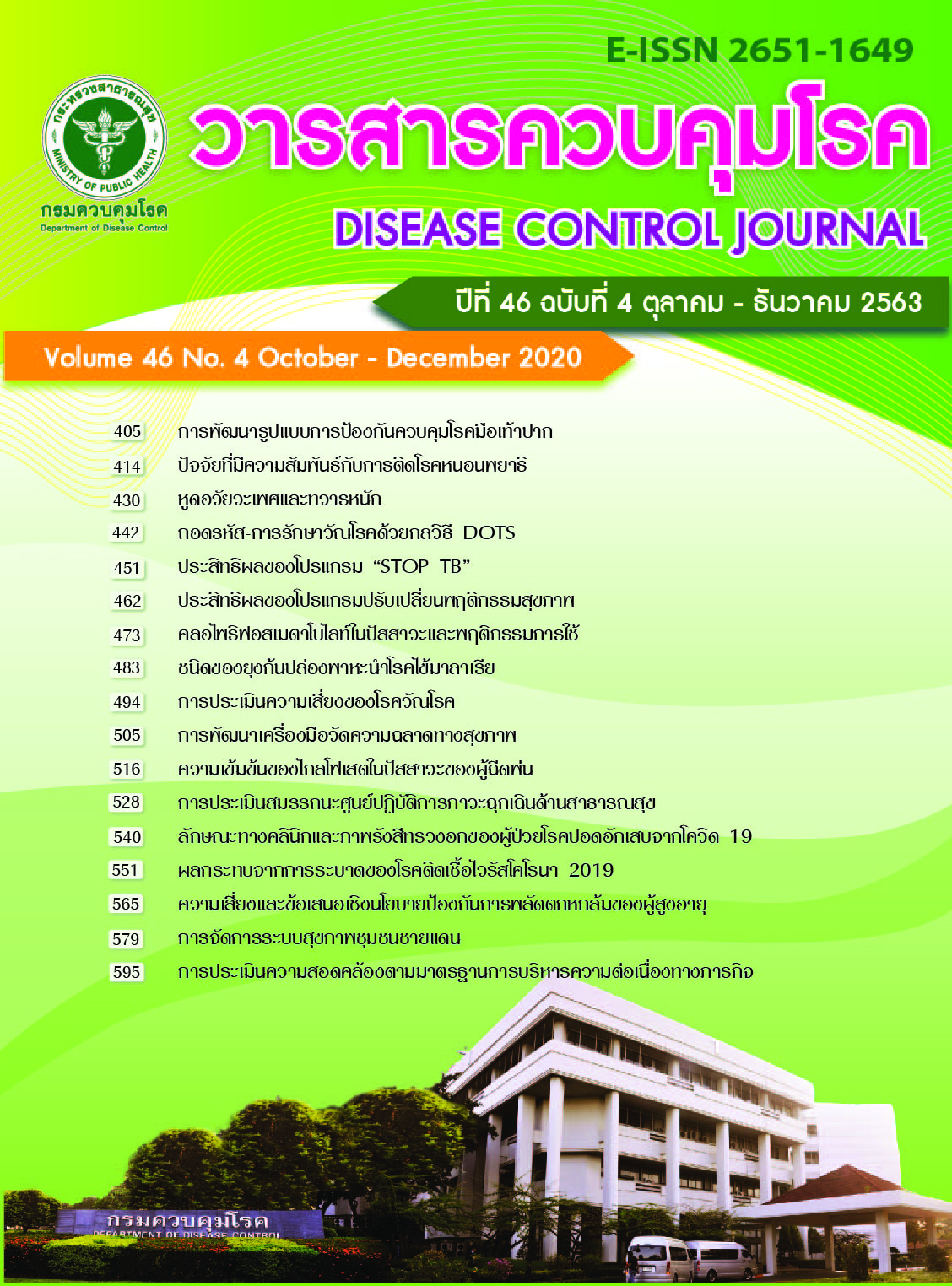The evaluating consistency standards of business continuity management sector, Department of Disease Control
DOI:
https://doi.org/10.14456/dcj.2020.54Keywords:
business continuity management, standard, relevance, organizations under the Department of Disease ControlAbstract
This study is evaluation research and the purposes were to evaluate the level of Business Continuity Management in health agencies under the Department of Disease Control (DDC) and compare business continuity management between the DDC’s national- and regional-level agencies. The samples included 30 health agencies under the DDC. The tool used for the study is an evaluation form for compliance of business continuity management developed by the study team. The statistics used for data analysis included frequency, percentage, mean, standard deviation, and t-test. The results of the study revealed that the DDC-affiliated agencies had achieved an overall score with respect to compliance with the standard requirements for business continuity management at a high level (X ̅ = 1.69), with the planning aspect achieving the highest score, followed by the performance evaluation, and the operations (X ̅ = 1.89, 1.83, and 1.76, respectively), while the improvement aspect received the lowest average score (X ̅ = 1.33). Based on the evaluation of average scores from 36 indicators of standard requirements, it was found that the indicator receiving the lowest average was the implementation of documented policy announcement on business continuity management, followed by analysis of the needs and expectations of customers and stakeholders, corrective actions and preventive actions to prevent nonconformity, reporting to follow-up on corrective actions, and exercising and testing of business continuity plan (X ̅ = 1.00, 1.03, 1.13, 1.13, and 1.20, respectively). Regarding the comparison study of business continuity management between the DDC’s national- and regional-level agencies, an overall assessment and the leadership, the operations, and the improvement aspects were found to have statistically significant difference of 0.05, while the organization context, planning, and support and improvement aspects had no statistically significant difference. To ensure efficient operations and compliance with the standard requirements with respect to business continuity management, senior management at DDC-affiliated organizations are recommended to review and announce a written policy on business continuity management so as to fulfil the commitment to implementing the activities that cover the survey of the needs and expectations of customers and stakeholders, prioritization of activities in support of the products, and provision of services that responds to the actual needs and appropriate expectations. In addition, the executive committee should also actively support the implementation of corrective actions and prevention of nonconformity identified through performance evaluation. Moreover, exercising and testing of the business continuity plan based on good international practices are also encouraged so as to ensure continued improvement of existing business continuity plan, concrete implementation of the plan, and periodical review. This will enable organizations to respond to and recover from disruptive incidents when they arise.
Downloads
References
Ministry of Interior. The national disaster prevention and mitigation plan 2548 B.E. Bangkok: National committee of Disaster Prevention and Mitigation; 2015. (in Thai)
Department of Disease Control (TH). Summary operating of Department of Disease Control in solving flooding problems 2011; Bangkok: the Department; 2011. (in Thai)
Tiansai P. An assessment of business continuity plan of flood prevention of factories in bang pa-in industrial estate [dissertation]. Bangkok: Thammasat University; 2016. 98 p. (in Thai)
Ministry of Industry. The notification of Ministery of Industry (No.130) B.E. 2556 (2013). Re: Business continuity management system-Indicator. Government Gazette No. 130. section 58 A (2013 September 25). (in Thai)
Thippayakrasorn S. Business continuity management…The way out of crisis. Panyapiwat Journal. 2012;4:68-7. (in Thai)
Office of the Prime Minister. The notification of Office of the Prime Minister (No.2) B.E. 2548 (2005). Re: Emergency decree on public administration in state of emergency. Government Gazette No. 122. section 58 A (2005 July 16). (in Thai)
Sangkhawan C. Strategic leadership. Bangkok: Se-Education; 2014. (in Thai)
Wibunsri YR. Evaluation research (socail action programs). 4th ed. Bankok: Chulalongkorn University Press; 2006. (in Thai)
Edwards III, George C. Implement public policy. In: Getsuwan R. Policy implementation. Bangkok: Se-Education; 2008. p. 219-21. (in Thai)
Paul A. Crisis communication. Lessons from 9/11. In: Larry B. Crisis Management. 6th ed. Masschusetts: Harvard business school press; 2006. p. 126-45.
Phucharoen S. Core competencies of executives in the reform era [Internet]. Thailand; 2009 [cited 2015 Mar 16]. Available from: http://www.kruinter.com/show.php?id_quiz=64&p=1 (in Thai)
Zellner G. A structured evaluation of business process improvement approaches. Business Process Management Journal [Internet]. 2011 [cited 2015 Apr 19]; 17:203-37. Available from: https://doi.org/10.1108/14637151111122329
Junteenok P. The strategy of using quality administration system: ISO 9001:2000 for the services of bank for agriculture and agricultural cooperatives office, Chaiyaphum Province [dissertation]. Chaiyaphum: Chaiyaphum Rajabhat University; 2007. 122 p. (in Thai)
Chris Z, Darrell R. How to think strategically in a recession. In: Larry B. Crisis management. 6th ed. Masschusetts: Harvard Business School Press; 2006. p. 170-82.
Downloads
Published
How to Cite
Issue
Section
License
Articles published in the Disease Control Journal are considered as academic work, research or analysis of the personal opinion of the authors, not the opinion of the Thailand Department of Disease Control or editorial team. The authors must be responsible for their articles.






